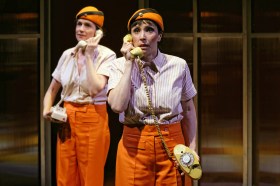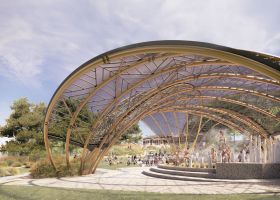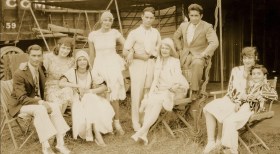First is Threading Through Fumes by Annie Hui-Hsin Hsieh, which incorporates cultural cross-fertilisation in its actual conception. The piece depicts the intertwining of two streams of incense smoke, but the composer’s introduction states this can also be seen as the interplay between two musical traditions. The piece easily evokes the image of fumes in the air. Softly played strings and bowed cymbals create sounds almost at the edge of hearing, intangible as smoke. Less successful is the distinction between the two strands of fumes. Though there is a variety of musical motives and instrumental combinations, they are never strongly established into groups before being mixed and melded. The result is still a piece is that it is atmospheric and beautiful.
The next work is Awakening by Christopher Larkin; the highlight of the afternoon. It moves through a series of changes as if through dreams into full consciousness. Each shift is marked with a note rung, gong-like, on a Tibetan bowl and the opening and closing gongs mean that the work seems to include the silences immediately before and after it, blurring the edges of the performance. This is also definitely the afternoon’s most accessible work, taking recognisable themes and developing them throughout the ensemble.
In each of the next two works, the composers primarily explored an aspect of the guqin.
In Kinu, Lachlan Shipworth concentrates on the natural pulsing harmonies of the instrument and echoes them in a small accompanying ensemble of strings and percussion. The result is much like meditation, with the strings standing in for concentration and the flares of sound from the percussion line holding the place of intruding thoughts and distractions.
In As The Dust Rises, Tristan Coelho takes the many unusual sounds of the guqin and mirrors them in the wider ensemble. Wide vibrato, wavering harmonies and scraping strings are echoed throughout the ensemble in imaginative and clever ways.
However, both of these works feel less like they were created with a clear musical intention and more like they were an exercise, or the exploration of a new instrument toy.
The concert finishes with Timothy Tate’s work, from thunder’s violence. Opening with a chaotic, angry thunderclap, the work then follows the five instrument lines as they try to move forward from this violent moment. The guqin is very much the voice of peace and (as so often seems to be the case) the bassoon is clearly the most traumatised member of the group, with the other parts fitting on a spectrum between these two. Special mention must go to Mark Gaydon for his outstanding performance on bassoon. Rather than being a journey towards serenity, the work shows the push a pull between personalities right up to the end, and it is not at all certain that a balance is ever reached. The piece is really a dialogue between two personalities, not five, as the three other parts are not distinctive enough to give them rich characters. However, the two that are fleshed out are very interesting.
With there being so few opportunities for emerging composers, this OzAsia and ASO residency is an exciting chance to see music from new minds, written in new styles.
Rating: 3 ½ stars out of 5
Crouching Tigers
Presented by Adelaide Festival Centre & Adelaide Symphony Orchestra
Adelaide Symphony Orchestra and Xiaoxia Zhao
Composers:
Tristan Coelho
Annie Hui-Hsin Hsieh
Christopher Larkin
Lachlan Shipworth
Timothy Tate
Performers:
Janet Anderson – Violin
Ewen Bramble – Cello
Mark Gaydon – Bassoon
Amanda Grigg – Percussion
Dean Newcomb – Clarinet
Martin Phillipson – Trumpet
Xiaoxia Zhao – Guqin
Space Theatre, Adelaide Festival Centre
September 23
2012 OzAsia Festival
September 14 – 30





